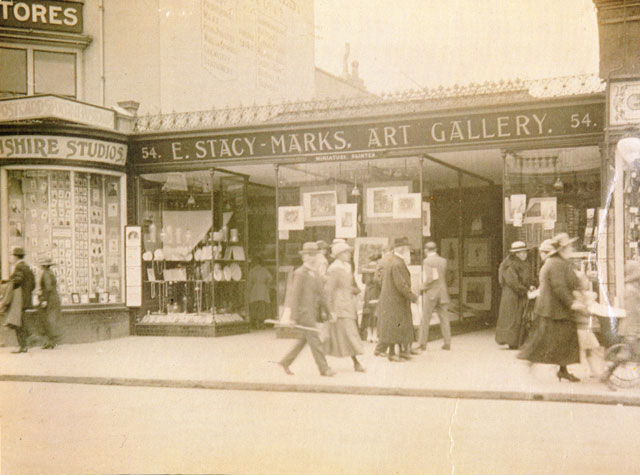The History of E. Stacy-Marks Ltd

The history of E. Stacy-Marks Ltd is really the life stories of three men, Edwin Stacy-Marks (1872-1926) the founder of the company, his son Ronald Stacy-Marks (1912-1987) who continued to develop the company with equal drive and imagination and currently Edwins' grandson Adam Stacy-Marks. Their personal involvement was fundamental in taking the company to it's present position as one of the best specialist fine art dealers in the United Kingdom. The unusual surname is made familiar by their relative, the artist Henry Stacy-Marks RA.
The earliest family records show Joe Marks, born in the 1730's, living in Liandefeilog near Carmarthen who was a cooper (a maker of casks or barrels). His son John Marks (1773-1828) married Sarah Stacy, whose family were well established coach builders. The Stacy family appear to have been without sons to take over the business because John Marks became manager of the company.
The centre of their coaching business in London was just north of Oxford Circus (one street is still called Riding House Street) area. At some point during this time John decided to join his wifes' name to his own, and so the twelve children all became Stacy-Marks. Of the twelve just two are of particular interest. The eldest and the tenth. John Isaac, the eldest, was the father of Henry Stacy-Marks RA (1829 - 1898), a well known painter in the pre-Raphaelite brotherhood, and Edwin, the tenth child, born in 1817, grandfather of the founder of E. Stacy-Marks Limited. He was an interesting man with diverse business concerns including trading with India, part ownership of an Iron Works in Hanley, Staffordshire and proprietor of an existing bookshop and print sellers in Royal Tunbridge Wells with a Royal Warrant. Of Edwins' eight other children, George Edwin (1842-1907) married Elizabeth Keats, and he was the father of Edwin Stacy-Marks, the company's founder.
 Edwin was born on the 13th November 1872 in the village of Hanley. He travelled to find work in Belfast in the antiques and fine art business and established his own business when he was still a teenager. As his clients lived in the outlying residential areas he purchased one of his first motorcycles.
Edwin was born on the 13th November 1872 in the village of Hanley. He travelled to find work in Belfast in the antiques and fine art business and established his own business when he was still a teenager. As his clients lived in the outlying residential areas he purchased one of his first motorcycles.
He moved to Royal Leamington Spa in 1898. This was the year that the prominent member of the Stacy-Marks family died, his cousin Henry, the Royal Academician.
The gallery that Edwin purchased was at 45 The Parade which was already an established supplier of artists materials and had enough space to exhibit original paintings, prints and sculptures. Royal Leamington Spa was a fashionable place at the time and the business prospered here, remaining at this address for fifteen years until the start of World War I in 1914.

The Gallery at 45 The Parade at the turn of the Century is on the left hand side of the above picture
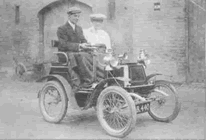 Edwins' interest in motor cars led to the purchase of a New Orleans Voiturette. He was looking for new locations to open another gallery and eventually settled on Royal Tunbridge Wells. The purchase of 51 High Street took place in 1912. In 1914 Edwin decided to open another gallery, this time in East bourne which was a very fashionable resort. Following his previous pattern, he purchased an already established business at 54 Terminus Road. Dealing with George Jenson Silver, Harlequin Glass, Royal Copenhagen and fine paintings this gallery became the home of the business for the next seventy two years!
Edwins' interest in motor cars led to the purchase of a New Orleans Voiturette. He was looking for new locations to open another gallery and eventually settled on Royal Tunbridge Wells. The purchase of 51 High Street took place in 1912. In 1914 Edwin decided to open another gallery, this time in East bourne which was a very fashionable resort. Following his previous pattern, he purchased an already established business at 54 Terminus Road. Dealing with George Jenson Silver, Harlequin Glass, Royal Copenhagen and fine paintings this gallery became the home of the business for the next seventy two years!
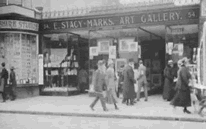 A new and more powerful had come onto the market called the Itala and Edwin hoped that it would make it easier to travel between his two galleries. The gallery in Royal Tunbridge Wells remained a successful concern for the next ten years but several incidents beyond his control led to his selling the property at 51 High Street in 1922. Some poor investments and two incidents on the continent had a very serious effect on his health at this time and he died of cancer in 1926.
A new and more powerful had come onto the market called the Itala and Edwin hoped that it would make it easier to travel between his two galleries. The gallery in Royal Tunbridge Wells remained a successful concern for the next ten years but several incidents beyond his control led to his selling the property at 51 High Street in 1922. Some poor investments and two incidents on the continent had a very serious effect on his health at this time and he died of cancer in 1926.
Born in Royal Tunbridge Wells on the 2nd of February 1912 Ronald spent a happy childhood learning by association many skills his father had acquired. He would help with maintenance, gallery work and carpentry, a skill his father had developed to a high degree. He was educated Canford School in Dorset and then he went into the gallery as his father had died so suddenly.
The early thirties were a slow period for most businesses, however records of sales from as far back as the turn of the century showed that many different items were being sold in addition to paintings. Sculpture, porcelain and glass from the world's best manufacturers all added to the reputation of the gallery. Paintings remained the main part of the business, taking over eighty percent of the display space. Later some of the more famous artists represented were Alfred Munnings, Eugene Boudin, Dorothea Sharp, Edward Seago, Montague Dawson, Sir William Russel Flint and Sir Gerald Kelly. There were numerous Victorian landscape artists and a unique collection of Dutch Romantic School paintings from the 19th Century.
The bleak political conditions that led up to the Second World War put a temporary end to the progress of the company when R. S-M (as Ronald was now called by most members of his staff) joined the R.N.V.R. at King Alfred,Hove in 1939 as a rating in Atlantic convoy duties on the cruiser HMS Berwick. He went on to serve commissioned as a sub-Lieutenant in HMS Malouine on Russian convoy duties to Murmansk and Gibraltar and North Africa runs.


After the war stock was gradually built up again, special vans were equipped for safe transportation of paintings, and attention paid to publicity and catalogues for exhibitions. R. S-M began to travel to his customers in different parts of the United Kingdom again just as his father had done. A number of trips to the continent after the war resulted in long-lasting arrangements with artists, some of whom he dealt with exclusively for many years.
The gallery at 54 Terminus Road which became number 74 in the thirties and 120-122 in the mid-fifties was expanded to a second and third floors of gallery and office space at that time, with further improvements in 1964. The works of nineteenth century English and Dutch artists and early English watercolours were supplemented by new artists such as Marcel Dyf, Pierre de Clausade, E. C. Rene-His, Charles Perron, Robert Chailloux, Gerald Cooper, Harold Clayton and many others. The growing number of customers at home and abroad were now receiving private invitations and catalogues several times a year. Exhibitions were being held throughout the country.

The family moved house in 1968 to a beautiful estate bordering open downland outside Eastbourne. Folkington Manor was built in 1843, by the architect William Donthorn near the site of a manor that was recorded in the doomsday book.
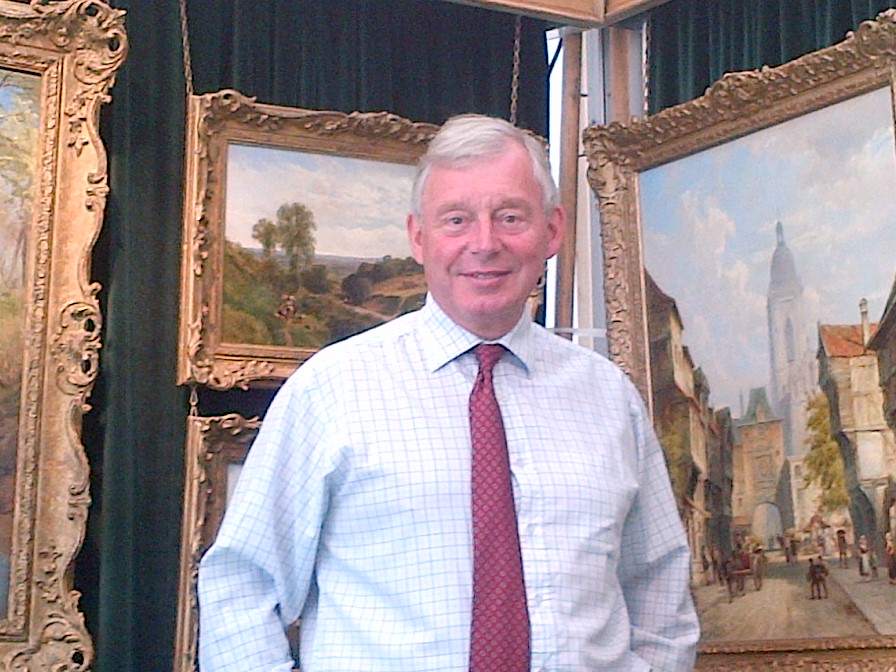
Adam Stacy-Marks joined the firm in August 1970 having also been educated at Canford School, having studied history of art at Perugia University and Fine Art courses later in Florence, Venice and Rome. He had started in the framing and packing department but eventually had progressed on to sales and management. He oversaw the move from Terminus Road to Cornfield Road in Eastbourne and further expansion of the Folkington Manor estate. This allowed in the early 1990’s the restoration of the two large rooms known as the ‘Flint Rooms’- so-called because they have a ‘knapped flint façade’. The town-based gallery and workshops were then consolidated there. It was not only a family home but a centre for special exhibitions, charity and musical events. The restored Stables was a first class livery establishment for 40 horses with a full sized dressage arena where competitions could be held.
At the age of seventy four R. S-M was still working, however his health was declining and he died on the 10th of August 1987, just as the firm had relocated in Eastbourne to 24 Cornfield Road.

Adam Stacy-Marks then took over the management of the family firm and oversaw the rebuilding and restoration of two further large rooms attached to the manor now known as 'The Flint Rooms', so called because they have a flint facade. By the early 1990's this enabled the town based galleries and workshops in Eastbourne to be relocated into one picturesque location with ample parking and beautiful surroundings.
In the late 1990's the galleries invested in a mobile articulated trailer show unit which travelled the length and breadth of the country. This had an extended awning and was self-sufficient with its own display fittings and lighting. During the summer months it travelled and showed at all of the main county, agricultural, horse and special events from Badminton to Burghley and the Royal Agricultural, Royal Highland and Royal Welsh shows to the Game Fair.

By 1997 another gallery country location was being sought that was approximately mid-way up the United Kingdom with charming surroundings, accessible and of a suitable size. On re-establishing contacts and clients all over the country through the travelling show. The second gallery was opened in the market town of Helmsley in the beautiful North Yorkshire Moors. It was refurbished using carpentry and display cabinets from the old galleries in Terminus Road in Eastbourne some 40 years earlier! Designed by R. S-M a generation earlier and saved. In 2008, the gallery moved in Helmsley to its Bond Gate premises and again in 2020, to its current Bridge Street location.

In 1997, RSM’s widow and shortly after in 2010 their younger son Nigel who had also established his own successful Gallery in Perth,Scotland passed away bringing further change. The Sussex family home, galleries and estate were sold and an office/showroom was located and set up conveniently in a farm near Lewes, Sussex. It is easily accessible for anyone requiring advice in the South of England ( by appointment).
The Sussex Gallery 2008 - 2010



The Helmsley Gallery 2010 - 2018

An office/showroom has been located and set up conveniently in a farm near Alfriston, Sussex, and is easily accessible for anyone requiring advice in the South of England (usually by appointment).
In 2014 to facilitate the display of our fine paintings and to publicise our 125th year, the firm invested in a newer mobile exhibition trailer.
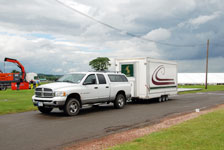
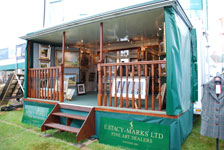
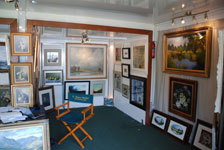
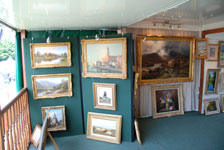
A 125 year on-line brochure was specially researched, written and illustrated with a cross section and variety of paintings by artists that E. Stacy-Marks Ltd has displayed and sold over the period. Today, the Gallery is primarily based in North Yorkshire but continues to attend Fine Art Fairs and selected Country Fairs and shows throughout the country.
The celebration of over one hundred years in this family business has involved many changes and developments. We hope that the history of E. Stacy-Marks given here will add to your understanding of E. Stacy-Marks and its tradition based on over a century of history as fine art dealers and the developments to continue to offer the same quality and service over the next century.
Exhibitions are also arranged annually in different parts of the UK, making it easier for our customers to visit and remain acquainted with our stock. Invitations and catalogues are posted on a regional basis to the people nearest the venue, we also exhibit at some of the main art and antique fairs.
The celebration of over one hundred years in this family business has involved many changes and developments. We hope that the history of E. Stacy-Marks given here will add to your understanding of E. Stacy-Marks and it's tradition based on over a century of history as fine art dealers and the developments to continue to offer the same quality and service over the next century.

